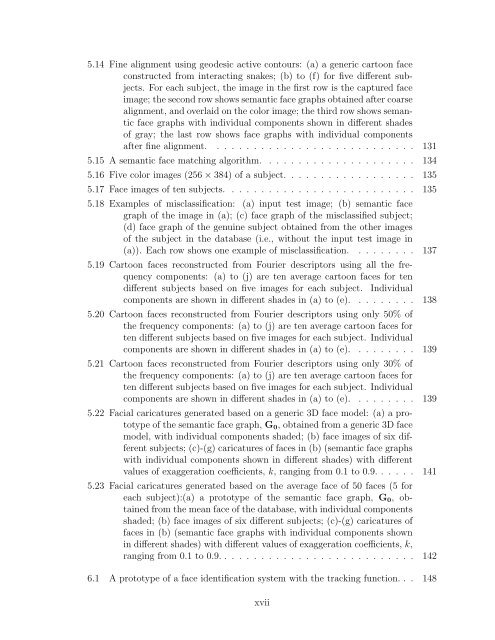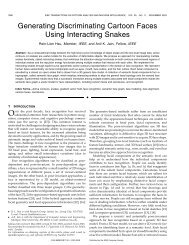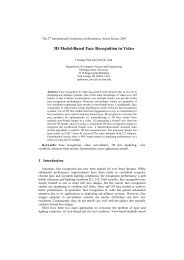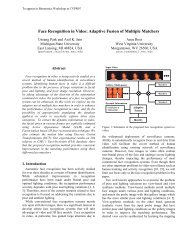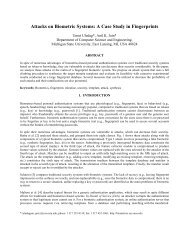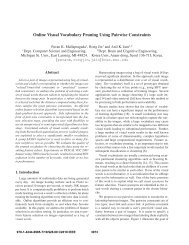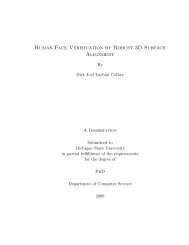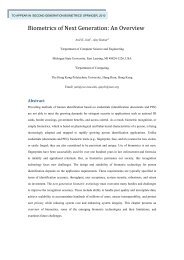Face Detection and Modeling for Recognition - Biometrics Research ...
Face Detection and Modeling for Recognition - Biometrics Research ...
Face Detection and Modeling for Recognition - Biometrics Research ...
You also want an ePaper? Increase the reach of your titles
YUMPU automatically turns print PDFs into web optimized ePapers that Google loves.
5.14 Fine alignment using geodesic active contours: (a) a generic cartoon face<br />
constructed from interacting snakes; (b) to (f) <strong>for</strong> five different subjects.<br />
For each subject, the image in the first row is the captured face<br />
image; the second row shows semantic face graphs obtained after coarse<br />
alignment, <strong>and</strong> overlaid on the color image; the third row shows semantic<br />
face graphs with individual components shown in different shades<br />
of gray; the last row shows face graphs with individual components<br />
after fine alignment. . . . . . . . . . . . . . . . . . . . . . . . . . . . 131<br />
5.15 A semantic face matching algorithm. . . . . . . . . . . . . . . . . . . . . 134<br />
5.16 Five color images (256 × 384) of a subject. . . . . . . . . . . . . . . . . . 135<br />
5.17 <strong>Face</strong> images of ten subjects. . . . . . . . . . . . . . . . . . . . . . . . . . 135<br />
5.18 Examples of misclassification: (a) input test image; (b) semantic face<br />
graph of the image in (a); (c) face graph of the misclassified subject;<br />
(d) face graph of the genuine subject obtained from the other images<br />
of the subject in the database (i.e., without the input test image in<br />
(a)). Each row shows one example of misclassification. . . . . . . . . 137<br />
5.19 Cartoon faces reconstructed from Fourier descriptors using all the frequency<br />
components: (a) to (j) are ten average cartoon faces <strong>for</strong> ten<br />
different subjects based on five images <strong>for</strong> each subject. Individual<br />
components are shown in different shades in (a) to (e). . . . . . . . . 138<br />
5.20 Cartoon faces reconstructed from Fourier descriptors using only 50% of<br />
the frequency components: (a) to (j) are ten average cartoon faces <strong>for</strong><br />
ten different subjects based on five images <strong>for</strong> each subject. Individual<br />
components are shown in different shades in (a) to (e). . . . . . . . . 139<br />
5.21 Cartoon faces reconstructed from Fourier descriptors using only 30% of<br />
the frequency components: (a) to (j) are ten average cartoon faces <strong>for</strong><br />
ten different subjects based on five images <strong>for</strong> each subject. Individual<br />
components are shown in different shades in (a) to (e). . . . . . . . . 139<br />
5.22 Facial caricatures generated based on a generic 3D face model: (a) a prototype<br />
of the semantic face graph, G 0 , obtained from a generic 3D face<br />
model, with individual components shaded; (b) face images of six different<br />
subjects; (c)-(g) caricatures of faces in (b) (semantic face graphs<br />
with individual components shown in different shades) with different<br />
values of exaggeration coefficients, k, ranging from 0.1 to 0.9. . . . . . 141<br />
5.23 Facial caricatures generated based on the average face of 50 faces (5 <strong>for</strong><br />
each subject):(a) a prototype of the semantic face graph, G 0 , obtained<br />
from the mean face of the database, with individual components<br />
shaded; (b) face images of six different subjects; (c)-(g) caricatures of<br />
faces in (b) (semantic face graphs with individual components shown<br />
in different shades) with different values of exaggeration coefficients, k,<br />
ranging from 0.1 to 0.9. . . . . . . . . . . . . . . . . . . . . . . . . . . 142<br />
6.1 A prototype of a face identification system with the tracking function. . . 148<br />
xvii


